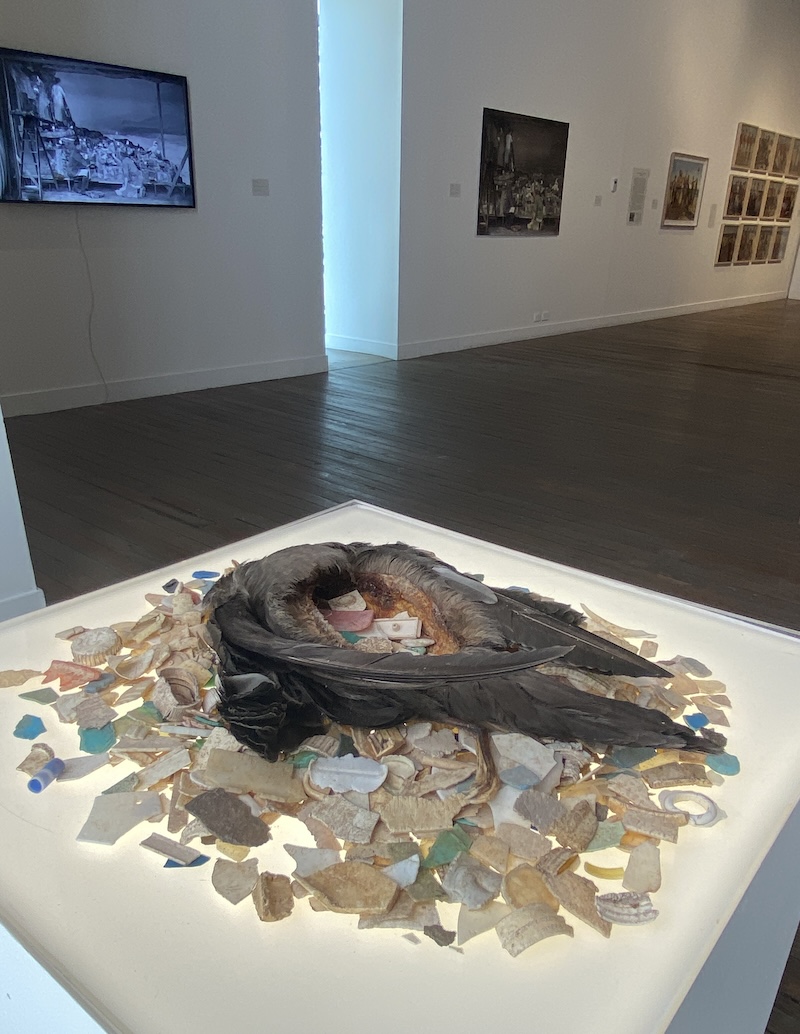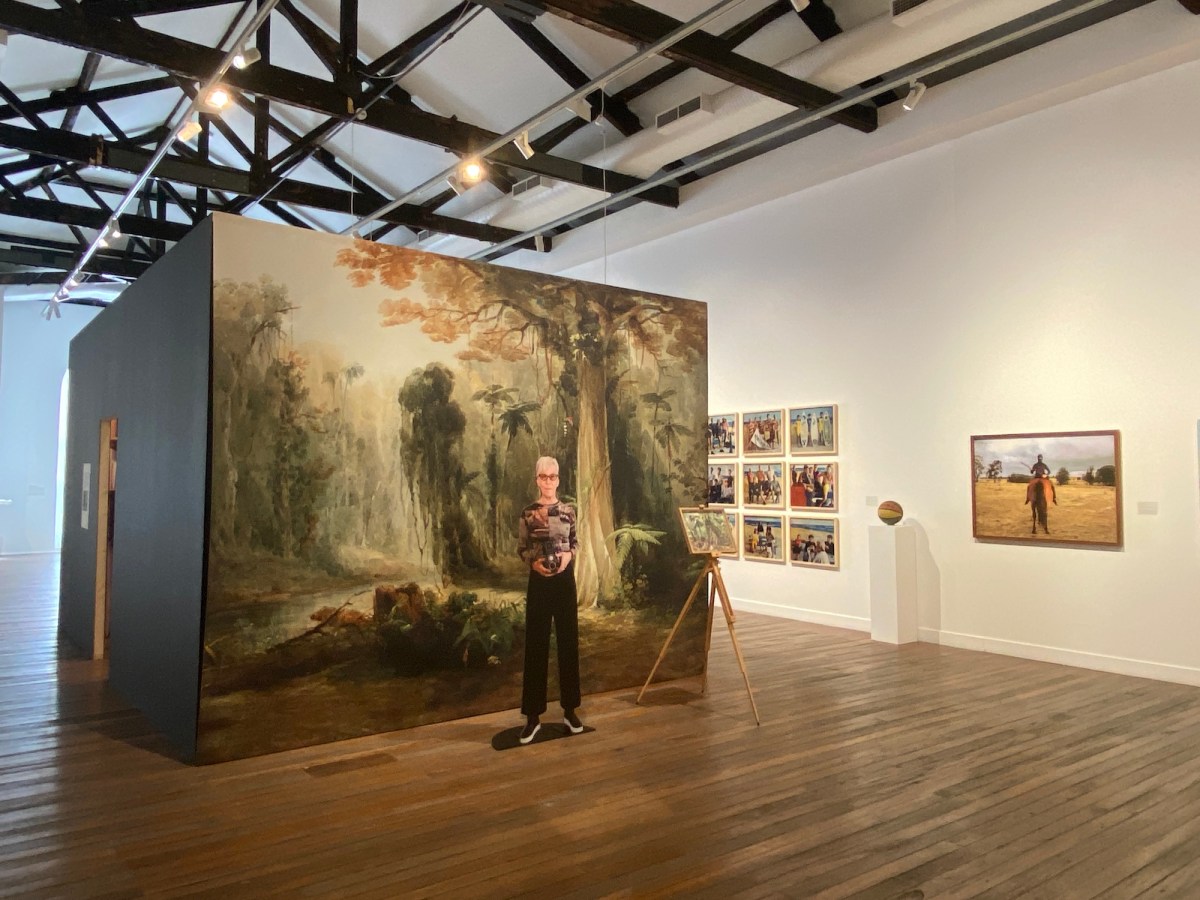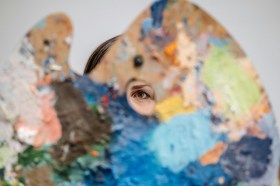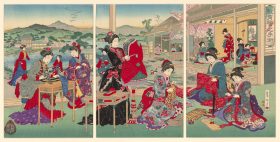I wasn’t sure what to expect with Anne Zahalka survey exhibition ZAHALKAWORLD – an artist’s archive, at NAS Gallery. It promised a quirkiness that has a popular appeal, but was it too much on volume? Knowing her work, however, it is a quirkiness that has a rigour to push the way we view photography into an alternative space – fun with a punch of realisation.
Walking into the exhibition, it doesn’t disappoint.
The two levels of the gallery have a very different feel and energy for the visitor: downstairs is full of drama, with highly-lit images set against black-toned walls. They seemingly lift off the wall with a quasi-animated quality, almost like light boxes.
One feels slightly voyeuristic peeking into something they shouldn’t – and it has a delicious appeal. In many cases, the sitter – in their everyday setting – peers out and connects with the viewer. It feels real and engaging.
Upstairs the tone shifts again. Viewers enter a world of nostalgia, of art history triggers and nature studies. It immediately feels familiar, and we are lulled with sweet humour, and yet all of these images have a probing conceptual core – whether challenging Australian “whiteness” in documented histories or our environment increasingly under threat.
Over the 40 years of her career, Anne Zahalka has carved out a unique voice, and her photomedia works have a foundation of deep research. This exhibition steps viewers through that persistent rethinking, and reframing, of how we imagine Australian identity. And yet it is void of the kind of pummel that some politically driven work has.
A great example is Zahalka’s re-gendering of Tom Robert’s iconic painting A break away! (1891), adding a flowing plait to the rider in her 1985 version included in her series The Landscape Re‑presented, another is inserting her migrant family into Frederick McCubbin’s monumental triptych The Pioneer (1904) as the brave vanguards.
Another highlight of the exhibition, which taps into a core thread of her making, is the series Wild Life, Wild Life Australia (2006/2017/2019), which was a major turning point, marking the moment she began to work digitally. Here she combines her fascination (and global research) of museum dioramas, taking the American Natural History Museum’s account and updating it with a lens from the Anthropocene, with rising sea levels and ocean pollution.
A stellar example draws upon the 1923 diorama, Sea Bird Colony from Admiralty Rocks with turbulent seas at Lord Howe island at the Australian Museum, which she has recreated in monotone, depicting its 60 nesting specimens surrounded by helium balloons and regurgitated plastics, highlighting the pollution in our seas.
It is shown within sight of a dissected taxidermied bird from Lord Howe Island, with the contents of its digestive tract laid bare around it.

ZAHALKAWORLD – an artist’s archive, was first exhibited at the Museum of Australian Photography (MAPh) in Melbourne (2023), and is currently showing at NAS Gallery – the first stop on a national tour.
The venue is not a surprise. Zahalka studied at the National Art School (NAS) in 1978, and was a photomedia teacher during the 1980s. Given that connection, the exhibition has taken on a different nuance for Sydney – six artworks from the school’s collection have been included, as well as five new works created since the exhibition was launched in Melbourne.
That tells us two things: Zahalka is prolific (despite being in her late 60s), and that she has a passion for histories and enlivening archives. This is immediately apparent to visitors entering the upper level of the gallery, where central to the space is a life-sized recreation of Zahalka’s studio, with her installation Kunstkammer.
It was awarded the Bowness Photography Prize 2023, and was acquired by MAPh. What I particularly like about experiencing this installation is that you can see fragment of hung artworks through its doorway – conceptually suturing thinking and outcome.
Read: 6 women artists over 60 having survey exhibitions
Other exhibition highlights include two series presented in the lower gallery: Hotel Suite (2008) and Open House (1995), which are softly confrontational in their everyday reality.
Stretched along one wall as a band of information, Hotel Suite was made during an artist residency at Sofitel Melbourne on Collins Street, and offers a sensitive glimpse behind closed doors – private moments of both guests and staff.

Likewise, Open House, takes us into the kitchens and living rooms of her sitters – who, without any direction, present their sense of a genuine, lived experience. These were made when Zahalka was in her 30s, and at a time when photography trends globally moved to a large-format, everyday zeal.
Her Bondi: Playground of the Pacific (1989/2013) images also need a quick mention as they were a huge part of her oeuvre, and visitors can step through a field of them upstairs. Here Zahalka takes her cue from mythologised tropes of beach culture, and inserts a “less Anglo” protagonist into the scene – softly saying, “Look at me, I’m Australian too.”

Working similarly to early photographers creating carte de visite portraits using staged tableaux, she invited locals to step in and usurp the space and narratives.
Read: Exhibition review: The Art of Banksy: Without Limits, Melbourne Docklands
Overall, this is an exhaustive exhibition – over 100 works from 15 key photographic series created over 40 years – and yet, one comes away feeling energised rather than exhausted. It is a stunning piece of curation, and it is delivered with such ease that we find ourselves lingering over tired national narratives – humour lulling us to pick them apart and, rather, embrace their new form.
It is fantastic that this exhibition is touring.
ZAHALKAWORLD – an artist’s archive, NAS Gallery at National Art School (NAS)
16 August – 19 October 2024
Free.





